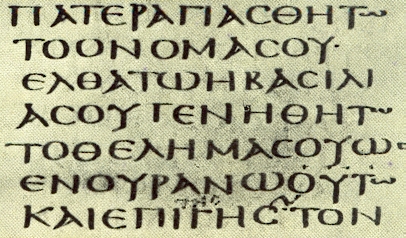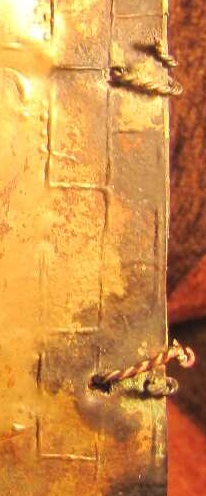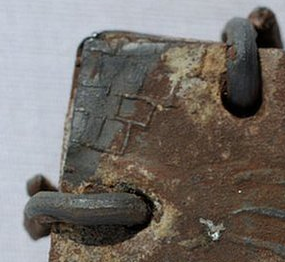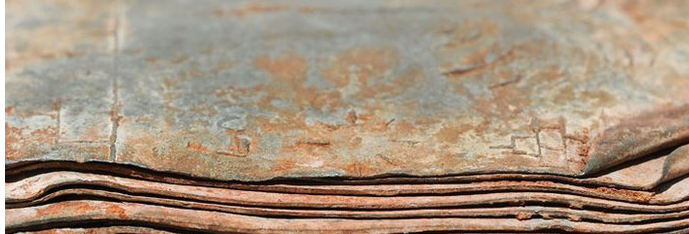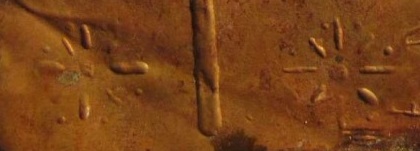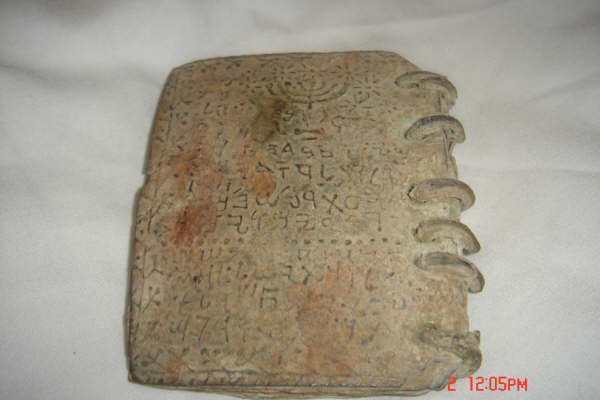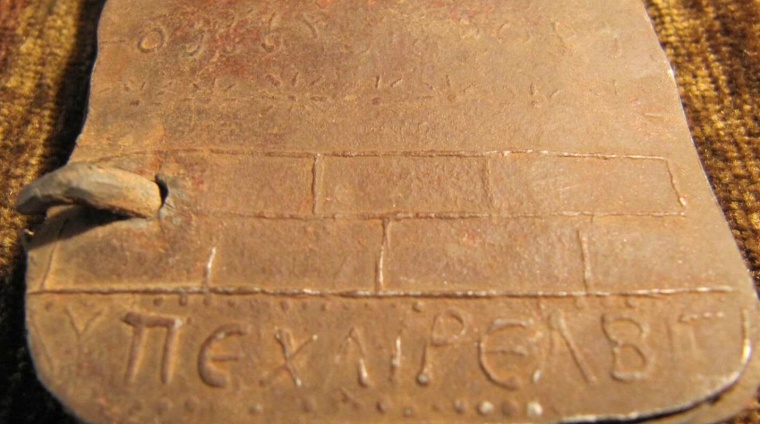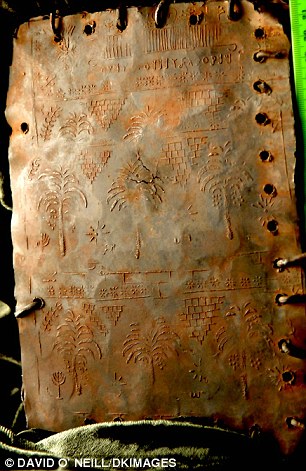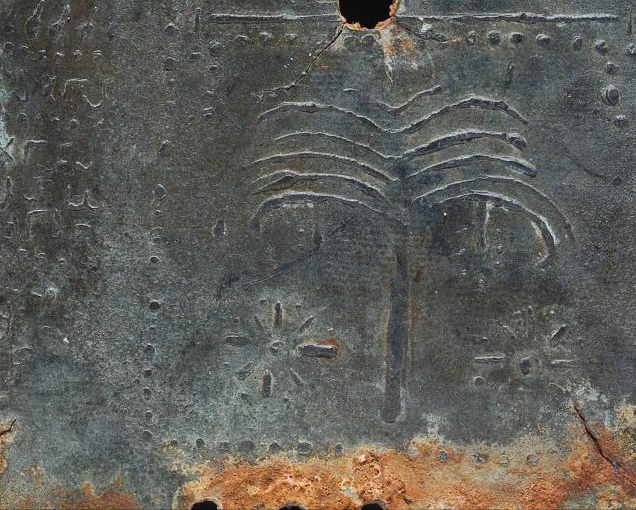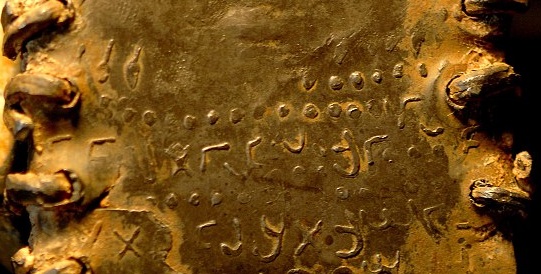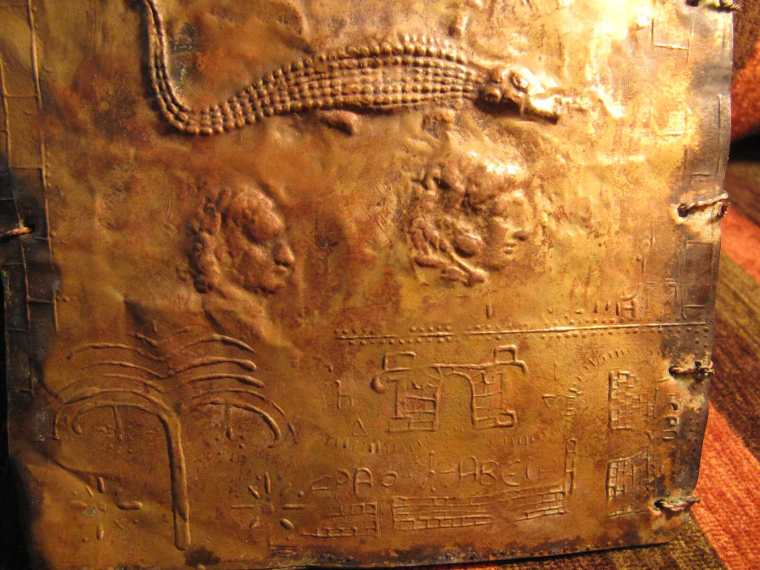 As Joel Watts pointed out a couple days ago, an anonymous person who claims to be part of the “team” investigating the Jordan Lead Codices has begun a Facebook group dedicated to them. As you might expect, the page presupposes the antiquity of the texts on the codices and asserts that the only people on the planet who are capable of reading the script (totaling five in number) are producing translations as fast as they can. “Stay tuned!” they advise.
As Joel Watts pointed out a couple days ago, an anonymous person who claims to be part of the “team” investigating the Jordan Lead Codices has begun a Facebook group dedicated to them. As you might expect, the page presupposes the antiquity of the texts on the codices and asserts that the only people on the planet who are capable of reading the script (totaling five in number) are producing translations as fast as they can. “Stay tuned!” they advise.
The most recent update is the claim today that the plate shown in this post is a forgery produced by Hassan Saida, the very Bedouin from whom the “authentic” codices came. Here is the post in full:
Approximately two months ago, Hassan Saida, the Israeli Bedouin who smuggled the Jordan Codices into Israel, telephoned to inform the team that he and his cohorts had made 500 forgeries of various of the codices and put them into the Jerusalem market. We didn’t think too much of it as he tells lots of tales; however, one of team members was sent these two photographs by someone who purchased them in Israel. To those who have seen the real McCoy, these were obvious forgeries. However, even comparing them to the posted photographs, the difference is all too apparent. Below are some observations made by one of the metal experts assisting the team. We expect more will materialise in due course.
1. The holes are too clean.
2. The beige ‘corrosion layer’ looks like it has been sprayed on and then cleaned off.
3. The holes have raised edges and looks like they have been punched hard all together against a die with a slightly larger diameter. Not like the originals.
4. The drawing on the tree is too fine and crisp – the detailing seems wrong – it is almost like they have been cast onto a harder material than the originals. It is also possible that these have been pressed and then distorted – the best indication would be a view of the reverse of each sheet and seeing if there is variation in the thickness of the metal from casting.
5. The edges look like they have been cut round the pattern very closely – particularly the dots – not the same as the previous ones which were not cut cleanly around a pattern.
6. The format looks wrong – too long and thin.
7. The seals – look like they have been struck at the ends – like coins. I didn’t see any of that before.
8. The background colour looks like it has been blowtorched – it is less rusty looking than most of the originals
9. They do not have the same build up of accretions of scale and calcium.
10. There is little or no evidence of wear or pressure based slow distortion – although there are a few damaging marks. Some of the wear may have been introduced on the mould. Unlike the originals, which looked like they were cleanly cast and then deteriorated over a long time.
11. The seals have been put on after the corrosion layer has been sprayed on and cleaned off. There should be layers of corrosion sealing them in to the surface.
12. The wires look hammer beaten – not a bad representation.
13. There are a few areas where the ‘blue’ of the lead shows through.
I can’t see the backs but your sealed books were sealed a very long time ago and opened up to clean and shiny lead – I bet these don’t.
I wonder if there are any rotational tool marks or bypass shear ‘seams’ along the edges where they have been cut.
The handwriting is very different and looks a bit too random. I haven’t attempted to look at the symbols – although they are more ragtag. I would say that a different person did the drawings from the script – they just look different.
The 8 pointed stars have 12 or 16 points. Some of the other symbols are slightly different and may have a completely different meaning or interpretation.
I would also reckon on the metal still being malleable. Not hard, flakey and cracking. I expect they also smell and taste different. These may have been dipped in acid and coloured with mineral pigments.
OK, I might be taken in if I hadn’t seen all your photos. But they don’t look right to me. A good mishmash of some of the symbols and text on the photos you and others have published on the Internet.
Several things are problematic with this development, as other bloggers have already noted. In addition to these concerns, though, it seems off to me that the metals expert quoted in the post is ostensibly commenting authoritatively on the script as well, stating that the symbols “may have a completely different meaning or interpretation” (as if forged symbols mean something different), and that the “handwriting is very different and looks a bit too random.” There is no tree and there are no symbols on the plate in the photograph, though. The post states two photos were provided the “expert,” but only one appears on Facebook. Perhaps there is another we’re not being shown.
Is this an attempt to account for the exposure of other codices as modern forgeries? If so, it falls well, well short of explaining the numerous genetic relationships shared between the script and iconography of the Thonemann codices and the others being promoted as genuine (see my discussion here and here). It also produces a rather unique codex that has little relationship to the other demonstrable forgeries. I can’t say the “team” involved in the promulgation of this hoax is impressing me with their craftiness.
EDIT: The Facebook page now has the second photo, with the symbols on it. Note that much of the script on this codex is actually quite similar to the script on the majority of the other codices that are being promoted as genuine (so are the rectangular patterns). THe iconography is much different, but I would argue it is intentionally so:






